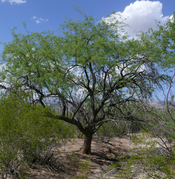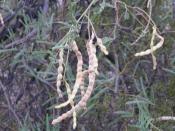The Velvet Mesquite
Prosopis juliflora var. velutina (velvet mesquite) is native to the Southwest region of the United States. Another specimen of P. velutina was found at Saguaro National Park East, located on the far east side of Tucson, Arizona. This particular tree was situated directly in front of the visitor center, deliberately planted at the side of the building with inadequate shade between the hours of 6 AM and noon in the summer and between noon and 8 PM in the winter. This is due to the visitors' center obstructing the light at certain parts of the day during different parts of the year. Despite the lack of morning sun, however, a forest ranger explained that this particular plant flourishes in the summer and remains green throughout the winter.
Aside from the obvious label at the base of the plant, Prosopis juliflora var. velutina was easily identified by the spines at the base of the leaf stems and several leftover bean pods on the stems of the tree.
These pods were also heavily fallen around the base of the tree trunk (unlike the specimen on the Old Main plant walk), ready for dry storage for a nearby ground squirrel, spotted snatching a few pods as the plant observation was made. Even though the pods on the Old Main plant walk specimen were not readily observable, the presence of feather-soft leaflet clusters on both specimens was also a sure-fire sign that this was indeed a velvet mesquite tree.
The wood of P. velutina plants is drought-hardy, an obvious adaptation to the arid desert climate (McPherson and McPherson 1979). It has been called "the mother of all hardwoods" (Kelley). Insects that enjoy the wood while it is still rooted are known to not enjoy it as much once the wood...


